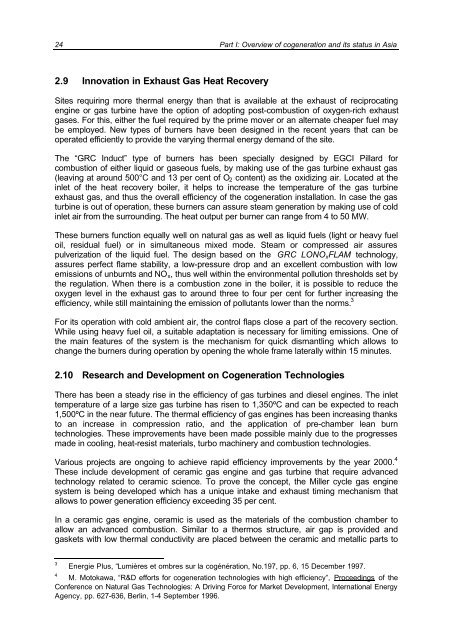part 1: overview of cogeneration and its status in asia - Fire
part 1: overview of cogeneration and its status in asia - Fire
part 1: overview of cogeneration and its status in asia - Fire
You also want an ePaper? Increase the reach of your titles
YUMPU automatically turns print PDFs into web optimized ePapers that Google loves.
24 Part I: Overview <strong>of</strong> <strong>cogeneration</strong> <strong>and</strong> <strong>its</strong> <strong>status</strong> <strong>in</strong> Asia<br />
2.9 Innovation <strong>in</strong> Exhaust Gas Heat Recovery<br />
Sites requir<strong>in</strong>g more thermal energy than that is available at the exhaust <strong>of</strong> reciprocat<strong>in</strong>g<br />
eng<strong>in</strong>e or gas turb<strong>in</strong>e have the option <strong>of</strong> adopt<strong>in</strong>g post-combustion <strong>of</strong> oxygen-rich exhaust<br />
gases. For this, either the fuel required by the prime mover or an alternate cheaper fuel may<br />
be employed. New types <strong>of</strong> burners have been designed <strong>in</strong> the recent years that can be<br />
operated efficiently to provide the vary<strong>in</strong>g thermal energy dem<strong>and</strong> <strong>of</strong> the site.<br />
The “GRC Induct” type <strong>of</strong> burners has been specially designed by EGCI Pillard for<br />
combustion <strong>of</strong> either liquid or gaseous fuels, by mak<strong>in</strong>g use <strong>of</strong> the gas turb<strong>in</strong>e exhaust gas<br />
(leav<strong>in</strong>g at around 500°C <strong>and</strong> 13 per cent <strong>of</strong> O2 content) as the oxidiz<strong>in</strong>g air. Located at the<br />
<strong>in</strong>let <strong>of</strong> the heat recovery boiler, it helps to <strong>in</strong>crease the temperature <strong>of</strong> the gas turb<strong>in</strong>e<br />
exhaust gas, <strong>and</strong> thus the overall efficiency <strong>of</strong> the <strong>cogeneration</strong> <strong>in</strong>stallation. In case the gas<br />
turb<strong>in</strong>e is out <strong>of</strong> operation, these burners can assure steam generation by mak<strong>in</strong>g use <strong>of</strong> cold<br />
<strong>in</strong>let air from the surround<strong>in</strong>g. The heat output per burner can range from 4 to 50 MW.<br />
These burners function equally well on natural gas as well as liquid fuels (light or heavy fuel<br />
oil, residual fuel) or <strong>in</strong> simultaneous mixed mode. Steam or compressed air assures<br />
pulverization <strong>of</strong> the liquid fuel. The design based on the GRC LONOxFLAM technology,<br />
assures perfect flame stability, a low-pressure drop <strong>and</strong> an excellent combustion with low<br />
emissions <strong>of</strong> unburnts <strong>and</strong> NOx, thus well with<strong>in</strong> the environmental pollution thresholds set by<br />
the regulation. When there is a combustion zone <strong>in</strong> the boiler, it is possible to reduce the<br />
oxygen level <strong>in</strong> the exhaust gas to around three to four per cent for further <strong>in</strong>creas<strong>in</strong>g the<br />
efficiency, while still ma<strong>in</strong>ta<strong>in</strong><strong>in</strong>g the emission <strong>of</strong> pollutants lower than the norms. 3<br />
For <strong>its</strong> operation with cold ambient air, the control flaps close a <strong>part</strong> <strong>of</strong> the recovery section.<br />
While us<strong>in</strong>g heavy fuel oil, a suitable adaptation is necessary for limit<strong>in</strong>g emissions. One <strong>of</strong><br />
the ma<strong>in</strong> features <strong>of</strong> the system is the mechanism for quick dismantl<strong>in</strong>g which allows to<br />
change the burners dur<strong>in</strong>g operation by open<strong>in</strong>g the whole frame laterally with<strong>in</strong> 15 m<strong>in</strong>utes.<br />
2.10 Research <strong>and</strong> Development on Cogeneration Technologies<br />
There has been a steady rise <strong>in</strong> the efficiency <strong>of</strong> gas turb<strong>in</strong>es <strong>and</strong> diesel eng<strong>in</strong>es. The <strong>in</strong>let<br />
temperature <strong>of</strong> a large size gas turb<strong>in</strong>e has risen to 1,350ºC <strong>and</strong> can be expected to reach<br />
1,500ºC <strong>in</strong> the near future. The thermal efficiency <strong>of</strong> gas eng<strong>in</strong>es has been <strong>in</strong>creas<strong>in</strong>g thanks<br />
to an <strong>in</strong>crease <strong>in</strong> compression ratio, <strong>and</strong> the application <strong>of</strong> pre-chamber lean burn<br />
technologies. These improvements have been made possible ma<strong>in</strong>ly due to the progresses<br />
made <strong>in</strong> cool<strong>in</strong>g, heat-resist materials, turbo mach<strong>in</strong>ery <strong>and</strong> combustion technologies.<br />
Various projects are ongo<strong>in</strong>g to achieve rapid efficiency improvements by the year 2000. 4<br />
These <strong>in</strong>clude development <strong>of</strong> ceramic gas eng<strong>in</strong>e <strong>and</strong> gas turb<strong>in</strong>e that require advanced<br />
technology related to ceramic science. To prove the concept, the Miller cycle gas eng<strong>in</strong>e<br />
system is be<strong>in</strong>g developed which has a unique <strong>in</strong>take <strong>and</strong> exhaust tim<strong>in</strong>g mechanism that<br />
allows to power generation efficiency exceed<strong>in</strong>g 35 per cent.<br />
In a ceramic gas eng<strong>in</strong>e, ceramic is used as the materials <strong>of</strong> the combustion chamber to<br />
allow an advanced combustion. Similar to a thermos structure, air gap is provided <strong>and</strong><br />
gaskets with low thermal conductivity are placed between the ceramic <strong>and</strong> metallic <strong>part</strong>s to<br />
3<br />
Energie Plus, “Lumières et ombres sur la cogénération, No.197, pp. 6, 15 December 1997.<br />
4 M. Motokawa, “R&D efforts for <strong>cogeneration</strong> technologies with high efficiency”, Proceed<strong>in</strong>gs <strong>of</strong> the<br />
Conference on Natural Gas Technologies: A Driv<strong>in</strong>g Force for Market Development, International Energy<br />
Agency, pp. 627-636, Berl<strong>in</strong>, 1-4 September 1996.









